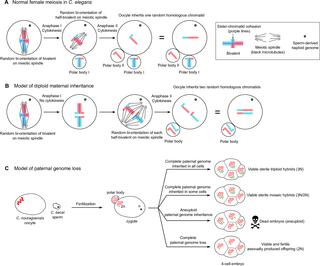当前位置:
X-MOL 学术
›
PLOS Genet.
›
论文详情
Our official English website, www.x-mol.net, welcomes your
feedback! (Note: you will need to create a separate account there.)
Hybridization promotes asexual reproduction in Caenorhabditis nematodes.
PLOS Genetics ( IF 4.0 ) Pub Date : 2019-12-16 , DOI: 10.1371/journal.pgen.1008520 Piero Lamelza 1, 2 , Janet M Young 3 , Luke M Noble 4 , Lews Caro 1, 2 , Arielle Isakharov 2 , Meenakshi Palanisamy 2 , Matthew V Rockman 4 , Harmit S Malik 1, 3, 5 , Michael Ailion 1, 2
PLOS Genetics ( IF 4.0 ) Pub Date : 2019-12-16 , DOI: 10.1371/journal.pgen.1008520 Piero Lamelza 1, 2 , Janet M Young 3 , Luke M Noble 4 , Lews Caro 1, 2 , Arielle Isakharov 2 , Meenakshi Palanisamy 2 , Matthew V Rockman 4 , Harmit S Malik 1, 3, 5 , Michael Ailion 1, 2
Affiliation

|
Although most unicellular organisms reproduce asexually, most multicellular eukaryotes are obligately sexual. This implies that there are strong barriers that prevent the origin or maintenance of asexuality arising from an obligately sexual ancestor. By studying rare asexual animal species we can gain a better understanding of the circumstances that facilitate their evolution from a sexual ancestor. Of the known asexual animal species, many originated by hybridization between two ancestral sexual species. The balance hypothesis predicts that genetic incompatibilities between the divergent genomes in hybrids can modify meiosis and facilitate asexual reproduction, but there are few instances where this has been shown. Here we report that hybridizing two sexual Caenorhabditis nematode species (C. nouraguensis females and C. becei males) alters the normal inheritance of the maternal and paternal genomes during the formation of hybrid zygotes. Most offspring of this interspecies cross die during embryogenesis, exhibiting inheritance of a diploid C. nouraguensis maternal genome and incomplete inheritance of C. becei paternal DNA. However, a small fraction of offspring develop into viable adults that can be either fertile or sterile. Fertile offspring are produced asexually by sperm-dependent parthenogenesis (also called gynogenesis or pseudogamy); these progeny inherit a diploid maternal genome but fail to inherit a paternal genome. Sterile offspring are hybrids that inherit both a diploid maternal genome and a haploid paternal genome. Whole-genome sequencing of individual viable worms shows that diploid maternal inheritance in both fertile and sterile offspring results from an altered meiosis in C. nouraguensis oocytes and the inheritance of two randomly selected homologous chromatids. We hypothesize that hybrid incompatibility between C. nouraguensis and C. becei modifies maternal and paternal genome inheritance and indirectly induces gynogenetic reproduction. This system can be used to dissect the molecular mechanisms by which hybrid incompatibilities can facilitate the emergence of asexual reproduction.
中文翻译:

杂交促进了线虫的无性繁殖。
尽管大多数单细胞生物都是无性繁殖,但大多数多细胞真核生物是专性有性繁殖的。这意味着存在强大的障碍,阻止来自专性性祖先的无性恋的起源或维持。通过研究稀有的无性动物物种,我们可以更好地了解促进它们从有性祖先进化而来的环境。在已知的无性动物物种中,许多起源于两个祖先有性物种之间的杂交。平衡假说预测,杂种中不同基因组之间的遗传不相容性可以改变减数分裂并促进无性繁殖,但很少有实例证明这一点。在这里,我们报道了两种有性线虫物种(C. nouraguensis 雌性和 C. becei 雄性)的杂交,在杂合子形成过程中改变了母本和父本基因组的正常遗传。该种间的大多数后代在胚胎发生过程中交叉死亡,表现出二倍体 C. nouraguensis 母本基因组的遗传和 C. becei 父本 DNA 的不完全遗传。然而,一小部分后代发育成可存活的成虫,可以是可育的,也可以是不育的。可育后代是通过依赖精子的孤雌生殖(也称为雌核生殖或假受精)无性产生的;这些后代继承了二倍体母本基因组,但未能继承父本基因组。不育后代是继承二倍体母本基因组和单倍体父本基因组的杂种。对单个活线虫的全基因组测序表明,可育和不育后代的二倍体母系遗传是线虫减数分裂改变的结果。 nouraguensis 卵母细胞和两个随机选择的同源染色单体的遗传。我们假设 C. nouraguensis 和 C. becei 之间的杂种不亲和性改变了母本和父本基因组遗传并间接诱导雌核生殖。该系统可用于剖析杂交不相容性促进无性繁殖出现的分子机制。
更新日期:2019-12-17
中文翻译:

杂交促进了线虫的无性繁殖。
尽管大多数单细胞生物都是无性繁殖,但大多数多细胞真核生物是专性有性繁殖的。这意味着存在强大的障碍,阻止来自专性性祖先的无性恋的起源或维持。通过研究稀有的无性动物物种,我们可以更好地了解促进它们从有性祖先进化而来的环境。在已知的无性动物物种中,许多起源于两个祖先有性物种之间的杂交。平衡假说预测,杂种中不同基因组之间的遗传不相容性可以改变减数分裂并促进无性繁殖,但很少有实例证明这一点。在这里,我们报道了两种有性线虫物种(C. nouraguensis 雌性和 C. becei 雄性)的杂交,在杂合子形成过程中改变了母本和父本基因组的正常遗传。该种间的大多数后代在胚胎发生过程中交叉死亡,表现出二倍体 C. nouraguensis 母本基因组的遗传和 C. becei 父本 DNA 的不完全遗传。然而,一小部分后代发育成可存活的成虫,可以是可育的,也可以是不育的。可育后代是通过依赖精子的孤雌生殖(也称为雌核生殖或假受精)无性产生的;这些后代继承了二倍体母本基因组,但未能继承父本基因组。不育后代是继承二倍体母本基因组和单倍体父本基因组的杂种。对单个活线虫的全基因组测序表明,可育和不育后代的二倍体母系遗传是线虫减数分裂改变的结果。 nouraguensis 卵母细胞和两个随机选择的同源染色单体的遗传。我们假设 C. nouraguensis 和 C. becei 之间的杂种不亲和性改变了母本和父本基因组遗传并间接诱导雌核生殖。该系统可用于剖析杂交不相容性促进无性繁殖出现的分子机制。











































 京公网安备 11010802027423号
京公网安备 11010802027423号